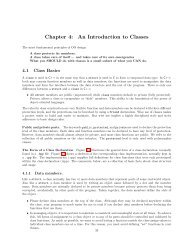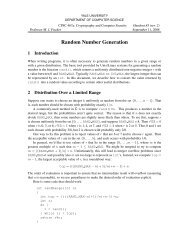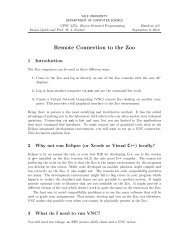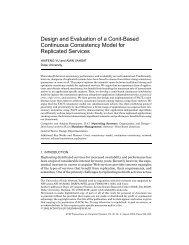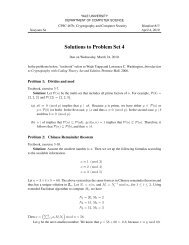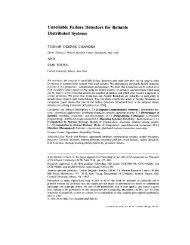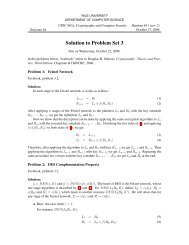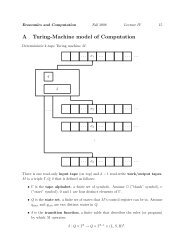Efficient Replica Maintenance for Distributed Storage Systems
Efficient Replica Maintenance for Distributed Storage Systems
Efficient Replica Maintenance for Distributed Storage Systems
You also want an ePaper? Increase the reach of your titles
YUMPU automatically turns print PDFs into web optimized ePapers that Google loves.
<strong>Efficient</strong> <strong>Replica</strong> <strong>Maintenance</strong> <strong>for</strong> <strong>Distributed</strong> <strong>Storage</strong> <strong>Systems</strong>Byung-Gon Chun, † Frank Dabek, ⋆ Andreas Haeberlen, ‡ Emil Sit, ⋆ Hakim Weatherspoon, †M. Frans Kaashoek, ⋆ John Kubiatowicz, † and Robert Morris ⋆⋆ MIT Computer Science and Artificial Intelligence Laboratory,‡ Rice University/MPI-SWS, † University of Cali<strong>for</strong>nia, BerkeleyAbstractThis paper considers replication strategies <strong>for</strong> storage systemsthat aggregate the disks of many nodes spread over the Internet.Maintaining replication in such systems can be prohibitively expensive,since every transient network or host failure could potentiallylead to copying a server’s worth of data over the Internetto maintain replication levels.The following insights in designing an efficient replication algorithmemerge from the paper’s analysis. First, durability canbe provided separately from availability; the <strong>for</strong>mer is less expensiveto ensure and a more useful goal <strong>for</strong> many wide-area applications.Second, the focus of a durability algorithm must beto create new copies of data objects faster than permanent diskfailures destroy the objects; careful choice of policies <strong>for</strong> whatnodes should hold what data can decrease repair time. Third,increasing the number of replicas of each data object does nothelp a system tolerate a higher disk failure probability, but doeshelp tolerate bursts of failures. Finally, ensuring that the systemmakes use of replicas that recover after temporary failure is criticalto efficiency.Based on these insights, the paper proposes the Carbonitereplication algorithm <strong>for</strong> keeping data durable at a low cost. Asimulation of Carbonite storing 1 TB of data over a 365 daytrace of PlanetLab activity shows that Carbonite is able to keepall data durable and uses 44% more network traffic than a hypotheticalsystem that only responds to permanent failures. Incomparison, Total Recall and DHash require almost a factor oftwo more network traffic than this hypothetical system.1 IntroductionWide-area distributed storage systems typically use replicationto provide two related properties: durability andavailability. Durability means that objects that an applicationhas put into the system are not lost due to disk failurewhereas availability means that get will be able to returnthe object promptly. Objects can be durably stored but notThis research was supported by the National Science Foundationunder Cooperative Agreement No. ANI-0225660, http://project-iris.net/. Andreas Haeberlen was supported in partby the Max Planck Society. Emil Sit was supported in part by theCambridge-MIT Institute. Hakim Weatherspoon was supported by anIntel Foundation PhD Fellowship.immediately available: if the only copy of an object is onthe disk of a node that is currently powered off, but willsomeday re-join the system with disk contents intact, thenthat object is durable but not currently available. The paper’sgoal is to develop an algorithm to store immutableobjects durably and at a low bandwidth cost in a systemthat aggregates the disks of many Internet nodes.The threat to durability is losing the last copy of an objectdue to permanent failures of disks. <strong>Efficient</strong>ly counteringthis threat to durability involves three main challenges.First, network bandwidth is a scarce resource ina wide-area distributed storage system. To store objectsdurably, there must be enough network capacity to createcopies of objects faster than they are lost due to diskfailure. Second, a system cannot always distinguish betweentransient failures and permanent disk failures: itmay waste network bandwidth by creating new copiesduring transient failures. Third, after recovery from transientfailures, some replicas may be on nodes that thereplica lookup algorithm does not query and are thus effectivelylost.Since transient failures are common in wide-area systems,replication algorithms can waste bandwidth by makingunneeded replicas. For example, the initial replicationalgorithm [6] that the DHash distributed hash table(DHT) [9] turned out to be inadequate to build storage applicationssuch as UsenetDHT [34], Antiquity [11], andOverCite [35, 36].A problem with DHash was that its design was drivenby the goal of achieving 100% availability; this decisioncaused it to waste bandwidth by creating new replicas inresponse to temporary failures. Its design and similar ones(such as Total Recall [3]) are overkill <strong>for</strong> durability. Furthermore,users of many Internet applications can toleratesome unavailability. For example, Usenet readers will seeall articles eventually, as long as they are stored durably.Our experience with these DHT applications has led us tothe following insights:• Durability is a more practical and useful goal thanavailability <strong>for</strong> applications that store objects (as op-
Figure 1: A continuous time Markov model <strong>for</strong> the processof replica failure and repair <strong>for</strong> a system that maintainsthree replicas (r L = 3). Numbered states correspondto the number of replicas of each object that are durable.Transitions to the left occur at the rate at which replicasare lost; right-moving transitions happen at the replicacreation rate.3.2 Creation versus failure rateIt might seem that any creation rate higher than the averagefailure rate will lead to an unbounded number ofreplicas, thus satisfying the burst constraint. However, thisintuition is false. To see why, let us model the number ofreplicas of an object as a birth-death process using a continuoustime Markov chain, which assumes independentexponential inter-failure and inter-repair times. This assumptionis reasonable <strong>for</strong> independent disk failures.An object is in state i when i disks hold a replica of theobject. There are thus r L + 1 possible states, as we startwith r L replicas and only create new replicas in responseto failures. From a given state i, there is a transition tostate i + 1 with rate µ i corresponding to repair, except <strong>for</strong>state 0 which corresponds to loss of durability and stater L which does not need repair. The actual rate µ i dependson how bandwidth is allocated to repair and may changedepending on the replication level of an object. There is atransition to the next lower state i−1 with rate iλ f becauseeach of the i nodes holding an existing replica might fail.Figure 1 shows this model <strong>for</strong> the case where r L = 3.This model can be analyzed numerically to shed lighton the impact of r L on the probability of data loss; we willshow this in Section 3.3. However, to gain some intuitionabout the relationship between creation and failure ratesand the impact this has on the number of replicas that canbe supported, we consider a simplification of Figure 1 thatuses a fixed µ but repairs constantly, even allowing <strong>for</strong>transitions out of state 0. While these changes make themodel less realistic, they turn the model into an M/M/∞queue [19] where the “arrival rate” is the repair rate andthe “service rate” is the per-replica failure rate. The “numberof busy servers” is the number of replicas: the morereplicas an object has, the more probable it is that one ofthem will fail.This simplification allows us to estimate the equilibriumnumber of replicas: it is µ/λ f . Given µ and λ f , asystem cannot expect to support more than this number ofreplicas. For example, if the system must handle coincidentalbursts of five failures, it must be able to support atleast six replicas and hence the replica creation rate mustbe at least 6 times higher than the average replica failurerate. We will refer to µ/λ f as θ. Choices <strong>for</strong> r L areeffectively limited by θ. It is not the case that durabilityincreases continuously with r L ; rather, when using r L > θ,the system provides the best durability it can, given its resourceconstraints. Higher values of θ decrease the timeit takes to repair an object, and thus the ‘window of vulnerability’during which additional failures can cause theobject to be destroyed.To get an idea of a real-world value of θ, we estimate µand λ f from the historical failure record <strong>for</strong> disks on PlanetLab.From Table 1, the average disk failure inter-arrivaltime <strong>for</strong> the entire test bed is 39.85 hours. On average,there were 490 nodes in the system, so we can estimate themean time between failures <strong>for</strong> a single disk as 490·39.85hours or 2.23 years. This translates to λ f ≈ 0.439 disk failuresper year.The replica creation rate µ depends on the achievablenetwork throughput per node, as well as the amountof data that each node has to store (including replication).PlanetLab currently limits the available networkbandwidth to 150 KB/s per node, and if we assume thatthe system stores 500 GB of unique data per node withr L = 3 replicas each, then each of the 490 nodes stores1.5 TB. This means that one node’s data can be recreatedin 121 days, or approximately three times per year. Thisyields µ ≈ 3 disk copies per year.In a system with these characteristics, we can estimateθ = µ/λ f ≈ 6.85, though the actual value is likely to belower. Note that this ratio represents the equilibrium numberof disks worth of data that can be supported; if a diskis lost, all replicas on that disk are lost. When viewed interms of disk failures and copies, θ depends on the valueof r L : as r L increases, the total amount of data stored perdisk (assuming available capacity) increases proportionallyand reduces µ. If λ f = µ, the system can in fact maintainr L replicas of each object.To show the impact of θ, we ran an experiment withthe synthetic trace (i.e., with 632 nodes, a failure rate ofλ f = 1 per year and a storage load of 1 TB), varying theavailable bandwidth per node. In this case, 100 B/s correspondsto θ = 1.81/r L . Figure 2 shows that, as θ dropsbelow one, the system can no longer maintain full replicationand starts operating in a ‘best ef<strong>for</strong>t’ mode, wherehigher values of r L do not give any benefit. The exceptionis if some of the initial r L replicas survive through the entiretrace, which explains the small differences on the leftside of the graph.
Pr[object durability]1.000.950.900.850.805 GB50 GB500 GB2 3 4 5 6 7 8rLFigure 4: Analytic prediction <strong>for</strong> object durability afterfour years on PlanetLab. The x-axis shows the initial numberof replicas <strong>for</strong> each object: as the number of replicasis increased, object durability also increases. Each curveplots a different per-node storage load; as load increases,it takes longer to copy objects after a failure and it is morelikely that objects will be lost due to simultaneous failures.consider only system designs in which every node has thesame scope. Scope can range from a minimum of r L to amaximum of the number of nodes in the system.A small scope means that all the objects stored on noden have copies on nodes chosen from the same restricted setof other nodes. The advantage of a small scope is that itmakes it easier to keep track of the copies of each object.For example, DHash stores the copies of all the objectswith keys in a particular range on the successor nodes ofthat key range; the result is that those nodes store similarsets of objects, and can exchange compressed summariesof the objects they store when they want to check that eachobject is replicated a sufficient number of times [6].The disadvantage of a small scope is that the ef<strong>for</strong>t ofcreating new copies of objects stored on a failed disk fallson the small set of nodes in that disk’s scope. The timerequired to create the new copies is proportional to theamount of data on one disk divided by the scope. Thusa small scope results in a long recovery time. Anotherproblem with a small scope, when coupled with consistenthashing, is that the addition of a new node may causeneedless copying of objects: the small scope may dictatethat the new node replicate certain objects, <strong>for</strong>cing the previousreplicas out of scope and thus preventing them fromcontributing to durability.Larger scopes spread the work of making new copiesof objects on a failed disk over more access links, so thatthe copying can be completed faster. In the extreme ofa scope of N (the number of nodes in the system), theremaining copies of the objects on a failed disk would bespread over all nodes, assuming that there are many moreobjects than nodes. Furthermore, the new object copiescreated after the failure would also be spread over all theDurability at end of trace1.0510.950.90.85rL=2rL=40.80 5 10 15 20 25ScopeFigure 5: Durability <strong>for</strong> different scopes in a synthetictrace with low θ. Larger scopes spread the repair workover more access links and improve the nodes’ ability tomonitor replicas and temporary failures, which results inhigher durability.nodes. Thus the network traffic sources and destinationsare spread over all the access links, and the time to recoverfrom the failure is short (proportional to the amount ofdata on one disk divided by N).A larger scope also means that a temporary failure willbe noticed by a larger number of nodes. Thus, more accesslinks are available to create additional replicas while thefailure lasts. Unless these links are already fully utilized,this increases the effective replica creation rate, and thusimproves durability.Figure 5 shows how scope (and thus repair time) affectsobject durability in a simulation on a synthetic trace.To reduce θ, we limit the bandwidth per node to 1000 B/sin this experiment. We vary the repair threshold and thescope, and measure durability after two years of simulatedtime. Increasing the scope from 5 to 25 nodes reduces thefraction of lost objects by an order of magnitude, independentof r L . By including more nodes (and thus morenetwork connections) in each repair ef<strong>for</strong>t, the work isspread over more access links and completes faster, limitingthe window of time in which the system is vulnerableto another disk failure. Ideally, by doubling the scope, thewindow of vulnerability can be cut in half.A large scope reduces repair time and increases durability;however, implementing a large scope presents twotrade-offs. First, the system must monitor each node inthe scope to determine the replication levels; when usinga large scope, the system must monitor many nodes. Thisincreased monitoring traffic limits scalability. Second, insome instances, a large scope can increase the likelihoodthat a simultaneous failure of multiple disks will causesome object to be lost.If objects are placed randomly with scope N and thereare many objects, then it is likely that all ( Nr L)potential
eplica sets are used. In this scenario, the simultaneousfailure of any r L disks is likely to cause data loss: there islikely to be at least one object replicated on exactly thosedisks. A small scope limits placement possibilities that areused, concentrating objects into common replica sets. Asa result, it is less likely that a given set of r L failures willaffect a replica set, but when data loss does occur, manymore objects will be lost. These effects exactly balance:the expected number of objects lost during a large failureevent is identical <strong>for</strong> both strategies. It is the variance thatdiffers between the two strategies.5 Reducing transient costsThe possibility of transient failures complicates providingdurability efficiently: we do not want to make new copiesin response to transient failures, but it is impossible to distinguishbetween disk failures and transient failures usingonly remote network measurements. This section focusesminimizing the amount of network traffic sent in responseto transient failures.The key technique needed to achieve this is to ensurethat the system reintegrates object replicas stored onnodes after transient failures; this means the system mustbe able to track more than r L replicas of each object. Thenumber of replicas that the system must remember turnsout to be dependent on a, the average fraction of time thata node is available. However, we show that the correctnumber of extra replicas can be determined without estimatinga by tracking the location of all replicas, includingthose that are offline. We introduce the Carbonite algorithmthat uses this technique and demonstrate its effectivenessusing simulations.We additionally consider two other techniques <strong>for</strong> limitingresponse to transient failures: creating extra replicasin batches and using timeouts as a heuristic <strong>for</strong> distinguishingtransient from disk failures. Both are of limitedvalue: batching is best able to save bandwidth when usingerasure codes and, in the presence of reintegration, timeoutswork well only if node downtimes are notably shorterthan node (and disk) lifetimes.5.1 Carbonite detailsThe Carbonite maintenance algorithm focuses on reintegrationto avoid responding to transient failures. Durabilityis provided by selecting a suitable value of r L ; an implementationof Carbonite should place objects to maximizeθ and preferentially repair the least replicated object.Within these settings, Carbonite works to efficientlymaintain r L copies, thus providing durability.Because it is not possible to distinguish between transientand disk failures remotely, Carbonite simply respondsto any detected failure by creating a new replica.This approach is shown in Figure 6. If fewer than r L replicasare detected as available, the algorithm creates enough// Iterate through the object database// and schedule an object <strong>for</strong> repair if neededMAINTAIN_REPLICAS ()keys = <strong>for</strong>each k in keys:n = replicas[k].len ()if (n < r L )newreplica = enqueue_repair (k)replicas[k].append (newreplica)Figure 6: Each node maintains a list of objects <strong>for</strong> whichit is responsible and monitors the replication level of eachobject using some synchronization mechanism. In thiscode, this state is stored in the replicas hash table thoughan implementation may choose to store it on disk. Thiscode is called periodically to enqueue repairs on those objectsthat have too few replicas available; the applicationcan issue these requests at its convenience.new replicas to return the replication level to r L .However, Carbonite remembers which replicas werestored on nodes that have failed so that they can be reusedif they return. This allows Carbonite to greatly reduce thecost of responding to transient failures. For example, if thesystem has created two replicas beyond r L and both fail,no work needs to be done unless a third replica fails be<strong>for</strong>eone of the two currently unavailable replicas returns.Once enough extra replicas have been created, it is unlikelythat fewer than r L of them will be available at anygiven time. Over time, it is increasingly unlikely that thesystem will need to make any more replicas.5.2 Reintegration reduces maintenanceFigure 7 shows the importance of reintegrating replicasback into the system by comparing the behavior of Carboniteto two prior DHT systems and a hypothetical systemthat can differentiate disk from transient failures usingan oracle and thus only reacts to disk failures. In the simulation,each system operates with r L = 3. The systems aresimulated against the PlanetLab trace (a) and a synthetictrace (b). The y-axes plot the cumulative number of bytesof network traffic used to create replicas; the x-axes showtime.Unlike all other synthetic traces used in this paper,whose parameters are different from the PlanetLab tracein order to bring out the basic underlying trends, the synthetictrace used in Figure 7 was configured to be similarto the PlanetLab trace. In particular, the average node lifetimeand the median downtime are the same. The resultis still an approximation (<strong>for</strong> example, PlanetLab grewduring the trace) but the observed per<strong>for</strong>mance is similar.Some of the observed differences are due to batching(used by Total Recall) and timeouts (used by all systems);the impact of these are discussed in more detail in Sections5.4 and 5.5.
Cumulative bytes sent (TB)1412108642CatesTotalRecall (rH=5)TotalRecall (rH=9)CarboniteOracleCumulative bytes sent (TB)1412108642CatesTotalRecall (rH=5)TotalRecall (rH=9)CarboniteOracle00 10 20 30 40 50Time (weeks)00 10 20 30 40 50Time (weeks)Disk failures200100DiskTransient2000010000Transient failuresDisk failures200100DiskTransient2000010000Transient failures00 10 20 30 40 50Time (weeks)(a)000 10 20 30 40 50Time (weeks)(b)0Figure 7: A comparison of the total amount of work done by different maintenance algorithms with r L = 3 using aPlanetLab trace (left) and a synthetic trace (right). In all cases, no objects are lost. However, r L = 2 is insufficient: <strong>for</strong>the PlanetLab trace, even a system that could distinguish permanent from transient failures would lose several objects.Since the oracle system responds only to disk failures,it uses the lowest amount of bandwidth. The line labeledCates shows a system that keeps track of exactly r L replicasper object; this system approximates the behavior ofDHTs like DHash, PAST and OpenDHT. Each failurecauses the number of replicas to drop below r L and causesthis system to create a new copy of an object, even if thefailure was transient. If the replica comes back online, it isdiscarded. This behavior results in the highest traffic rateshown. The difference in per<strong>for</strong>mance between the PlanetLaband Poisson trace is due to differences in the distributionof downtimes: Poisson is not a particularly good fit<strong>for</strong> the PlanetLab downtime distribution.Total Recall [3] tracks up to a fixed number of replicas,controlled by a parameter r H ; we show r H = 5 which isoptimal <strong>for</strong> these traces, and r H = 9. As can be seen atthe right of the graphs, this tracking of additional replicasallows Total Recall to create fewer replicas than theCates system. When more than r L replicas are available, atransient failure will not cause Total Recall to make a newcopy. However, Total Recall’s per<strong>for</strong>mance is very sensitiveto r H . If r H is set too low, a series of transient failureswill cause the replication level to drop below r L and <strong>for</strong>ceit to create an unnecessary copy. This will cause Total Recallto approach Cates (when r H = r L ). Worse, when thesystem creates new copies it <strong>for</strong>gets about any copies thatare currently on failed nodes and cannot benefit from thereturn of those copies. Without a sufficiently long memory,Total Recall must make additional replicas. Settingr H too high imposes a very high insertion cost and resultsin work that may not be needed <strong>for</strong> a long time.Carbonite reintegrates all returning replicas into thereplica sets and there<strong>for</strong>e creates fewer copies than TotalRecall. However, Carbonite’s inability to distinguish betweentransient and disk failures means that it producesand maintains more copies than the oracle based algorithm.This is mainly visible in the first weeks of the traceas Carbonite builds up a buffer of extra copies. By the endof the simulations, the rate at which Carbonite producesnew replicas approaches that of the oracle system.5.3 How many replicas?To <strong>for</strong>malize our intuition about the effect of extra replicason maintenance cost and to understand how many extrareplicas are necessary to avoid triggering repair followinga transient failure, consider a simple Bernoulli processmeasuring R, the number of replicas available at a givenmoment, when there are r > r L total replicas. The availabilityof each node is a. Since repair is triggered when thenumber of available replicas is less than r L , the probabilitythat a new replica needs to be created is the probability
Pr[repair action]1.00.80.60.40.2a = 0.5a = 0.7a = 0.9Total bytes sent (TB)600500400300200With reintegrationWithout reintegration0.04 6 8 10 12Number of replicasFigure 8: Additional redundancy must be created whenthe amount of live redundancy drops below the desiredamount (3 replicas in this example). The probability ofthis happening depends solely on the average node availabilitya and the amount of durable redundancy. Thisgraph shows the probability of a repair action as a functionof the amount of durable redundancy, with a = 0.5,a = 0.7 and a = 0.9 <strong>for</strong> a replication system.10000 2 4 6 8 10 12Extra replicasFigure 9: Total repair cost with extra replicas, and withand without reintegration after repair. Without reintegration,extra replicas reduce the rate at which repair is triggeredand thus reduce maintenance cost; there is an optimalsetting (here e = 8). With reintegration, the cost islowest if no extra replicas are used.that less than r L replicas are available:r L −1( ) rPr[R < r L |r extant copies] = ∑ a i (1 − a) r−i .i=0iThis probability falls rapidly as r increases but it willnever reach zero; there is always a chance that a replicamust be created due to a large number of concurrent failures,regardless of how many replicas exist already. However,when a large number of replicas exists, it is extremelyunlikely that enough replicas fail such that fewerthan r L are available.By computing the Chernoff bound, it is possible toshow that after the system has created 2r L /a replicas,the probability of a new object creation is exponentiallysmall. 2r L /a is a rough (and somewhat arbitrary) estimateof when the probability of a new object creation is smallenough to ignore. Figure 8 shows (on the y-axis) the probabilitythat a new object must be created when an increasingnumber of replicas already exist. As r increases, theprobability that a new replica needs to be created falls,and the algorithm creates replicas less frequently. As rapproaches 2r L /a, the algorithm essentially stops creatingreplicas, despite not knowing the value of a.This benefit is obtained only if returning replicas arereintegrated into the appropriate replica set, allowingmore than r L to be available with high probability. As aresult, the cost of responding to transient failures will benearly zero. Still, this system is more expensive than anoracle system that can distinguish between disk and transientfailures. While the latter could maintain exactly r Lreplicas, the <strong>for</strong>mer has to maintain approximately 2r L /a.The factor of 2/a difference in the cost is the penalty <strong>for</strong>not distinguishing disk and transient failures.5.4 Create replicas as neededGiven that the system tends towards creating 2r L /a replicasin order to keep r L of them available, it is tempting tocreate the entire set—not just r L of them—when the objectis first inserted into the system (Total Recall [3] usesa similar technique). However, this approach requires anaccurate estimate <strong>for</strong> a to deliver good per<strong>for</strong>mance. If ais overestimated, the system quickly finds itself with lessthan r L replicas after a string of transient failures and is<strong>for</strong>ced to create additional copies. If a is underestimated,the system creates unneeded copies and wastes valuableresources. Carbonite is simplified by the fact that it doesnot need to measure or estimate a to create the “correct”number of replicas.Another idea is to create not only enough copies tobring the number of available replicas back up to r L , butalso e additional copies beyond r L (this is similar to TotalRecall’s lazy repair technique). Creating a batch ofcopies makes repair actions less frequent, but at the sametime, causes more maintenance traffic than Carbonite. Thework required to create additional replicas will be wastedif those replicas are lost due to disk failures be<strong>for</strong>e they areactually required. Carbonite, on the other hand, only createsreplicas that are necessary to keep r L replicas available.In other words, either Carbonite would eventuallycreate the same number of replicas as a scheme that createsreplicas in batches, or some replicas created in thebatch were unnecessary: batch schemes do, at best, thesame amount of work as Carbonite.Figure 9 shows the bytes sent in a simulation experimentusing a five-year synthetic trace with a = 0.88,
L = 3, and an average node lifetime of one year. Thegraph shows results <strong>for</strong> different values of e (in TotalRecall, e = r H − r L ) and <strong>for</strong> two different scenarios. Inthe scenario with reintegration, the system reintegrates allreplicas as they return from transient failures. This scenariorepresents the behavior of Carbonite when e = 0 andcauses the least traffic.In the scenario without reintegration, replicas that areunavailable when repair is triggered are not reintegratedinto the replica set even if they do return. Total Recall behavesthis way. Extra replicas give the system a short-termmemory. Additional replicas increase the time until repairmust be made (at which time failed replicas will be <strong>for</strong>gotten);during this time failed replicas can be reintegrated.Larger values of e give the system a longer memory butalso put more data at risk of failure: on this synthetic trace,a value of e = 8 is optimal. Taking advantage of returningreplicas is simpler and more efficient than creating additionalreplicas: a system that reintegrates returning replicaswill always make fewer copies than a system that doesnot and must replace <strong>for</strong>gotten replicas.For systems that use erasure codes, there is an additionalread cost since a complete copy of the object isneeded in order to generate a new fragment [32]. Thecost of reading a sufficient number of fragments priorto recreating a lost fragment can overwhelm the savingsthat erasure codes provide. A common approach is toamortize this cost by batching fragment creation but simplycaching the object at the node responsible <strong>for</strong> repairis much more effective. A simulation contrasting bothcaching and batching (but both with reintegration) showsresults similar to Figure 9: caching the object with a 7/14erasure code uses 85% of the bandwidth that the optimalbatching strategy would use.5.5 TimeoutsA common approach to reduce transient costs is to uselong timeouts, as suggested by Blake [4]. Timeouts area heuristic to avoid misclassifying temporary failures aspermanent: failures are considered to be permanent onlywhen the corresponding node has not responded <strong>for</strong> somenumber of seconds. Longer timeouts reduce the numberof misclassified transient failures and thus the number ofrepairs. On the other hand, a longer timeout also increasesthe latency between failure and repair in the event of a truedisk failure; if additional permanent failures occur duringthis larger “window of vulnerability,” data may be lost.The goal of both reintegrating replicas and use of timeoutsis to reduce the number of repairs without decreasingdurability. Figure 7 demonstrates that reintegration iseffective <strong>for</strong> Carbonite. However, it also illustrates thattimeouts are important in systems without reintegration:on the PlanetLab trace, the timeout used is able to mask87.7% of transient failures whereas it only masks 58.3%of transient failures on the Poisson trace. If replicas arereintegrated, what extra benefit does a timeout provide?Timeouts are most effective when a significant percentageof the transient failures can be ignored, which is dependenton the downtime distribution. However, <strong>for</strong> durabilityto remain high, the expected node lifetime needs tobe significantly greater than the timeout.To evaluate this scenario where timeouts should haveimpact, we per<strong>for</strong>med an experiment using a synthetictrace where we varied the repair threshold and the nodetimeout. Since the system would recognize nodes returningafter a permanent failure and immediately expire allpending timeouts <strong>for</strong> these nodes, we assigned new identitiesto such nodes to allow long timeouts to expire normally.Figure 10 shows the results of this simulation: (a)shows the total bytes sent as a function of timeout while(b) shows the durability at the end of the trace. As thelength of the timeout increases past the average downtime,we observe a reduction in the number of bytes sentwithout a decrease in durability. However, as the timeoutgrows longer, durability begins to fall: the long timeoutdelays the point at which the system can begin repair, reducingthe effective repair rate. Thus setting a timeout canreduce response to transient failures but its success dependsgreatly on its relationship to the downtime distributionand can in some instances reduce durability as well.6 Implementing CarboniteWhile the discussion of durability and efficient maintenancemay be broadly applicable, in this section, we focuson our experience in implementing Carbonite in thecontext of distributed hash tables (DHTs).In a DHT, each node is algorithmically assigned a portionof the total identifier space that it is responsible <strong>for</strong>maintaining. Carbonite requires that each node know thenumber of available replicas of each object <strong>for</strong> which it isresponsible. The goal of monitoring is to allow the nodesto track the number of available replicas and to learn ofobjects that the node should be tracking but is not awareof. When a node n fails the new node n ′ that assumes responsibilityof n’s blocks begins tracking replica availability;monitored in<strong>for</strong>mation is soft state and thus can befailed over to a "successor" relatively transparently.Monitoring can be expensive: a node might have to contactevery node in the scope of each object it holds. Whiledeveloping two prototype implementations of Carbonitein the PlanetLab environment, we found it necessary todevelop different techniques <strong>for</strong> monitoring: the monitoringproblem is slightly different in systems that use distributeddirectories and those that use consistent hashing.Figure 11 illustrates the structures of these systems.The Chord/DHash system [8, 9] served as the basis <strong>for</strong>our consistent hashing implementation. It uses a small
251.05Total bytes sent (TB)2015105rL=2rL=3rL=4rL=500.1 1 10 100 1000 10000Timeout (hours)Durability (at end of trace)10.950.90.85rL=2rL=3rL=4rL=50.80.1 1 10 100 1000 10000Timeout (hours)(a)(b)Figure 10: The impact of timeouts on bandwidth and durability on a synthetic trace. Figure 10(a) shows the numberof copies created <strong>for</strong> various timeout values; (b) shows the corresponding object durability. In this trace, the expecteddowntime is about 29 hours. Longer timeouts allow the system to mask more transient failures and thus reduce maintenancecost; however, they also reduce durability.¥¡¥¡¥¦¡¦¦¡¦¥¡¥¡¥successor list¢¡¢¢¡¢ £¡££¡£¤¡¤¤¡¤<strong>Replica</strong>sID Space(a) DHT§¨§©¨©successor list¨¨¨¨¨ID Space<strong>Replica</strong>¨¨¨¨¨¨¨¨<strong>Replica</strong>(b) Directory(location−pointerreplicas)<strong>Replica</strong>¨¨¨¨Figure 11: DHT- and Directory- Based <strong>Storage</strong> SystemArchitectures.scope and thus monitors a small number of nodes. DHashdoes not need to record the location of failed replicas: anode will return to the same place in the ring and thusthe same replica sets, as long as it returns with the samelogical identifier.We used Oceanstore [20,30] and the BambooDHT [31]to develop a distributed directory system using large scopeand random placement. Oceanstore must maintain pointersto all nodes that have ever held data <strong>for</strong> a given objectand has a scope of N. Responsibility <strong>for</strong> keys is still assignedusing consistent hashing: the pointer database <strong>for</strong>each key is replicated on the successors of the key. In thiscase, the location of objects is hard state. Un<strong>for</strong>tunately,it could be easy <strong>for</strong> this system to have very high monitoringcosts: if each node communicate with every othernode periodically, the resulting N 2 probe traffic may limitthe system’s scalability.6.1 Monitoring consistent hashing systemsIn systems that use a small scope, it is possible to makean end-to-end check that data is stored on the disk of eachnode. The naive way to do this is to arrange <strong>for</strong> nodesto repeatedly exchange key lists, but such an exchangewould be extremely costly.DHash uses a synchronization protocol based onMerkle trees [6] that takes advantage of the fact that mostobjects are typically correctly placed. In this commoncase, adjacent nodes store largely similar keys and twonodes can exchange a single message (containing a digestof the stored keys) to verify that they are synchronized.Carbonite allows replicas to be placed anywhere in theplacement scope. This flexibility lets the system avoidmoving and replicating objects during most joins (untilthe system grows dramatically). However, it also causesthe Merkle synchronization protocol to operate outside ofits common case: adjacent nodes are no longer likely tostore nearly identical sets of objects. In this environmentthe synchronizer “discovers” that nodes in the scope aremissing objects each time it is run. Repeatedly exchangingthis in<strong>for</strong>mation can be costly: if the synchronizationprotocol runs once a minute, the cost of repeatedly transferringthe 20-byte key of an 8 KB data object will exceedthe cost of transferring the object itself to a newly joinednode in about 8 hours.To avoid this problem, each node maintains, <strong>for</strong> eachobject, a list of nodes in the scope without a copy of theobject. The node uses this in<strong>for</strong>mation to adjust its Merkletree to avoid re-learning the in<strong>for</strong>mation again during thenext run of the synchronizer. For instance, when a noden synchronizes with a replica node n ′ that is known to bemissing an object with key k, n leaves k out of the Merkle
tree used <strong>for</strong> synchronization: this prevents n ′ from reportingwhat n already knew. The amount of extra state neededto per<strong>for</strong>m this optimization per object is small relative tothe size of storing the object itself, and can be maintainedlazily, unlike the object itself which is hard state.6.2 Monitoring host availabilityIn a directory-style system, the same synchronizationtechniques just described can be used to monitor the directoryitself (which is replicated on successor nodes);however, it is likely infeasible to explicitly monitor theliveness of objects themselves using the algorithm describedabove since two nodes are not likely to store thesame keys. Instead, node availability can be monitored asa proxy <strong>for</strong> object availability. Node availability can bemonitored using a multicast mechanism that propagatesthe liveness state of each node to each other node.The DHT’s routing tables are used to establish a uniquespanning tree rooted at each node a O(logN) out-degreeper node. Each node periodically broadcasts a heartbeatmessage to its children in the tree; this message includes ageneration identifier that is randomly generated when thenode is installed or reinstalled following a disk failure.The children rebroadcast the heartbeat to their childrenuntil it is received by all nodes.Over time, each node expects to receive regular notificationof node liveness. If a heartbeat is missed, the monitoringnode triggers repair <strong>for</strong> every object stored on thenewly down node. When a node returns and its generationidentifier has not changed, the monitoring node can concludethat objects stored on that node are again accessible.7 Related work7.1 <strong>Replica</strong>tion analysisThe use of a birth-death data-loss model is a departurefrom previous analyses of reliability. Most DHT evaluationsconsider whether data would survive a single eventinvolving the failure of many nodes [8,40]. This approachdoes not separate durability from availability, and does notconsider the continuous bandwidth consumed by replacingreplicas lost to disk failure.The model and discussion in this paper is similar tocontemporary work that looks at churn [37] and analyzesthe expected object lifetime [29]. The birth-death model isa generalization of the calculations that predict the MTBF<strong>for</strong> RAID storage systems [26]. Owing to its scale, a distributedsystem has more flexibility to choose parameterssuch as the replication level and number of replica setswhen compared to RAID systems.Blake and Rodrigues argue that wide-area storage systemsbuilt on unreliable nodes cannot store a large amountof data [4]. Their analysis is based on the amount of datathat a host can copy during its lifetime and mirrors our discussionof feasibility. We come to a different conclusionbecause we consider a relatively stable system membershipwhere data loss is driven by disk failure, while theyassumed a system with continual membership turnover.The selection of a target replication level <strong>for</strong> survivingbursts differs from many traditional fault tolerant storagesystems. Such systems, designed <strong>for</strong> single-site clusters,typically aim to continue operating despite some fixednumber of failures and choose number of replicas so thata voting algorithm can ensure correct updates in the presenceof partitions or Byzantine failures [5, 17, 23, 24, 33].FAB [33] and Chain <strong>Replica</strong>tion [38] both considerhow the number of possible replicas sets affects data durability.The two come to opposite conclusions: FAB recommendsa small number of replica sets since more replicasets provide more ways <strong>for</strong> data to fail; chain replicationrecommends many replica sets to increase repair parallelismand thus reduce repair time. These observationsare both correct: choosing a replica placement strategy requiresbalancing the probability of losing some data itemduring a simultaneous failure (by limiting the number ofreplica sets) and improving the ability of the system totolerate a higher average failure rate (by increasing thenumber of replica sets and reconstruction parallelism).Weatherspoon et al [39] studied the increased costs dueto transient failures. Their results quantify the benefitsof maintaining extra replicas in reducing these transientcosts. However, their analysis focuses on systems that <strong>for</strong>getabout extant replicas that exist when repair is initiatedand do not discuss the benefits of reintegrating them.7.2 <strong>Replica</strong>ted systems<strong>Replica</strong>tion has been widely used to reduce the risk ofdata loss and increase data availability in storage systems(e.g., RAID [26], System R duplex disks [16], Harp [23],xFS [2], Petal [21], DDS [17], GFS [15]). The algorithmstraditionally used to create and maintain data redundancyare tailored <strong>for</strong> the environment in which these systemsoperate: well-connected hosts that rarely lose data or becomeunavailable. As a result they can maintain a small,fixed number of replicas and create a new replica immediatelyfollowing a failure. This paper focuses on wide-areasystems that are bandwidth-limited, where transient networkfailures are common, and where it is difficult to tellthe difference between transient failures and disk failures.<strong>Distributed</strong> databases [10], online disaster recoverysystems such as Myriad [22], and storage systems [12,13, 27] use replication and mirroring to distribute loadand increase durability. These systems store mutable dataand focus on the cost of propagating updates, a considerationnot applicable to the immutable data we assume.In some cases, data is replicated between a primary andbackup sites and further replicated locally at each site usingRAID. Wide area recovery is initiated only after site
failure; individual disk failure can be repaired locally.Total Recall is the system most similar to our work [3].We borrow from Total Recall the idea that creating andtracking additional replicas can reduce the cost of transientfailures. Total Recall’s lazy replication keeps a fixednumber of replicas and fails to reincorporate replicas thatreturn after a transient failure if a repair had been per<strong>for</strong>med.Total Recall also requires introspection or guessingto determine an appropriate high water mark that Carbonitecan arrive at naturally.Glacier [18] is a distributed storage system that usesmassive replication to provide data durability across largescalecorrelated failure events. The resulting tradeoffs arequite different from those of Carbonite, which is designedto handle a continuous stream of at small-scale failureevents. For example, due to its high replication level,Glacier can af<strong>for</strong>d very long timeouts and thus mask almostall transient failures.8 Conclusions and future workInexpensive hardware and the increasing capacity ofwide-area network links have spurred the development ofapplications that store a large amount of data on wide-areanodes. However, the feasibility of applications based ondistributed storage systems is currently limited by the expenseof maintaining data. This paper has described a setof techniques that allow wide-area systems to efficientlystore and maintain large amounts of data.These techniques have allowed us to develop and deployprototypes of UsenetDHT [34], OverCite [35], andAntiquity [11]. These systems must store large amountsof data durably and were infeasible without the techniqueswe have presented. In the future, we hope to report on ourlong-term experience with these systems.Acknowledgments The authors would like to thankVivek Pai and Aaron Klingaman <strong>for</strong> their assistance incompiling the data used <strong>for</strong> the PlanetLab traces. This paperhas benefited considerably from the comments of theanonymous reviewers and our shepherd, Larry Peterson.References[1] ANDERSEN, D. Improving End-to-End Availability Using OverlayNetworks. PhD thesis, Massachusetts Institute of Technology,2004.[2] ANDERSON, T. E., DAHLIN, M. D., NEEFE, J. M., PATTERSON,D. A., ROSELLI, D. S., AND WANG, R. Y. Serverless networkfile systems. In Proc. of the 15th ACM Symposium on OperatingSystem Principles (Dec. 1995).[3] BHAGWAN, R., TATI, K., CHENG, Y.-C., SAVAGE, S., ANDVOELKER, G. M. Total Recall: System support <strong>for</strong> automatedavailability management. In Proc. of the 1st Symposium on Networked<strong>Systems</strong> Design and Implementation (Mar. 2004).[4] BLAKE, C., AND RODRIGUES, R. High availability, scalable storage,dynamic peer networks: Pick two. In Proc. of the 9th Workshopon Hot Topics in Operating <strong>Systems</strong> (May 2003), pp. 1–6.[5] CASTRO, M., AND LISKOV, B. Practical byzantine fault toleranceand proactive recovery. ACM Transactions on Computer <strong>Systems</strong>20, 4 (2002), 398–461.[6] CATES, J. Robust and efficient data management <strong>for</strong> a distributedhash table. Master’s thesis, Massachusetts Institute of Technology,May 2003.[7] DABEK, F. A <strong>Distributed</strong> Hash Table. PhD thesis, MassachusettsInstitute of Technology, 2005.[8] DABEK, F., KAASHOEK, M. F., KARGER, D., MORRIS, R., ANDSTOICA, I. Wide-area cooperative storage with CFS. In Proc. ofthe 18th ACM Symposium on Operating System Principles (Oct.2001).[9] DABEK, F., LI, J., SIT, E., ROBERTSON, J., KAASHOEK, M. F.,AND MORRIS, R. Designing a DHT <strong>for</strong> low latency and highthroughput. In Proc. of the 1st Symposium on Networked <strong>Systems</strong>Design and Implementation (Mar. 2004).[10] DEMERS, A., GREENE, D., HAUSER, C., IRISH, W., LARSON,J., SHENKER, S., STURGIS, H., SWINEHART, D., AND TERRY,D. Epidemic algorithms <strong>for</strong> replicated database maintenance. InProc. of the 6th ACM Symposium on Principles of <strong>Distributed</strong>Computing (1987), pp. 1–12.[11] EATON, P., WEATHERSPOON, H., AND KUBIATOWICZ, J. <strong>Efficient</strong>lybinding data to owners in distributed content-addressablestorage systems. In Proc. of the 3rd International Security in <strong>Storage</strong>Workshop (Dec. 2005).[12] EMC. Centera—content addressed storage system. http://www.emc.com/products/systems/centera.jsp. Lastaccessed March 2006.[13] EMC. Symmetrix remote data facility. http://www.emc.com/products/networking/srdf.jsp. Last accessedMarch 2006.[14] FREEDMAN, M. J., LAKSHMINARAYANAN, K., RHEA, S., ANDSTOICA, I. Non-transitive connectivity and DHTs. In Proc. of the2nd Workshop on Real Large <strong>Distributed</strong> <strong>Systems</strong> (Dec. 2005).[15] GHEMAWAT, S., GOBIOFF, H., AND LEUNG, S.-T. The Googlefile system. In Proc. of the 2003 19th ACM Symposium on OperatingSystem Principles (Oct. 2003).[16] GRAY, J., MCJONES, P., BLASGEN, M., LINDSAY, B., LORIE,R., PRICE, T., PUTZOLU, F., AND TRAIGER, I. The recoverymanager of the System R database manager. ACM Computing Surveys13, 2 (1981), 223–242.[17] GRIBBLE, S., BREWER, E., HELLERSTEIN, J., AND CULLER,D. Scalable, distributed data structures <strong>for</strong> internet service construction.In Proc. of the 4th Symposium on Operating <strong>Systems</strong>Design and Implementation (Oct. 2004).[18] HAEBERLEN, A., MISLOVE, A., AND DRUSCHEL, P. Glacier:Highly durable, decentralized storage despite massive correlatedfailures. In Proc. of the 2nd Symposium on Networked <strong>Systems</strong>Design and Implementation (May 2005).[19] KLEINROCK, L. Queueing <strong>Systems</strong>, Volume I: Theory. John Wiley& Sons, Jan. 1975.[20] KUBIATOWICZ, J., BINDEL, D., CHEN, Y., CZERWINSKI, S.,EATON, P., GEELS, D., GUMMADI, R., RHEA, S., WEATH-ERSPOON, H., WEIMER, W., WELLS, C., AND ZHAO, B.OceanStore: An architecture <strong>for</strong> global-scale persistent storage.In Proc. of the 9th Intl. Conference on Architectural Support <strong>for</strong>Programming Languages and Operating <strong>Systems</strong> (Nov. 2000),pp. 190–201.[21] LEE, E. K., AND THEKKATH, C. A. Petal: <strong>Distributed</strong> virtualdisks. In Proc. of the 7th Intl. Conference on Architectural Support<strong>for</strong> Programming Languages and Operating <strong>Systems</strong> (1996),pp. 84–92.
[22] LEUNG, S.-T. A., MACCORMICK, J., PERL, S. E., AND ZHANG,L. Myriad: Cost-effective disaster tolerance. In Proc. of the 1stUSENIX Conference on File and <strong>Storage</strong> Technologies (Jan. 2002).[23] LISKOV, B., GHEMAWAT, S., GRUBER, R., JOHNSON, P.,SHRIRA, L., AND WILLIAMS, M. <strong>Replica</strong>tion in the Harp filesystem. In Proc. of the 13th ACM Symposium on Operating SystemPrinciples (Oct. 1991), pp. 226–38.[24] LITWIN, W., AND SCHWARZ, T. LH* RS : A high-availabilityscalable distributed data structure using reed solomon codes. InProc. of the 2000 ACM SIGMOD Intl. Conference on Managementof Data (May 2000), pp. 237–248.[25] PARK, K. S., AND PAI, V. CoMon: a mostly-scalable monitoringsystem <strong>for</strong> PlanetLab. ACM SIGOPS Operating <strong>Systems</strong> Review40, 1 (Jan. 2006), 65–74. http://comon.cs.princeton.edu/.[26] PATTERSON, D., GIBSON, G., AND KATZ, R. A case <strong>for</strong> redundantarrays of inexpensive disks (RAID). In Proc. of the ACMSIGMOD International Conference on Management of Data (June1988).[27] PATTERSON, H., MANLEY, S., FEDERWISCH, M., HITZ, D.,KLEIMAN, S., AND OWARA, S. Snapmirror: File system basedasynchronous mirroring <strong>for</strong> disaster recovery. In Proc. of the 1stUSENIX Conference on File and <strong>Storage</strong> Technologies (Jan. 2002).[28] PETERSON, L., ANDERSON, T., CULLER, D., AND ROSCOE, T.A blueprint <strong>for</strong> introducing disruptive technology into the Internet.In Proc. of the First ACM Workshop on Hot Topics in Networks(Oct. 2002). http://www.planet-lab.org.[29] RAMABHADRAN, S., AND PASQUALE, J. Analysis of longrunningreplicated systems. In Proc. of the 25th IEEE Annual Conferenceon Computer Communications (INFOCOM) (Apr. 2006).[30] RHEA, S., EATON, P., GEELS, D., WEATHERSPOON, H., ZHAO,B., AND KUBIATOWICZ, J. Pond: the OceanStore prototype. InProc. of the 2nd USENIX Conference on File and <strong>Storage</strong> Technologies(Apr. 2003).[31] RHEA, S., GEELS, D., ROSCOE, T., AND KUBIATOWICZ, J.Handling churn in a DHT. In Proc. of the 2004 Usenix AnnualTechnical Conference (June 2004).[32] RODRIGUES, R., AND LISKOV, B. High availability in DHTs:Erasure coding vs. replication. In Proc. of the 4th InternationalWorkshop on Peer-to-Peer <strong>Systems</strong> (Feb. 2005).[33] SAITO, Y., FRŒLUND, S., VEITCH, A., MERCHANT, A., ANDSPENCE, S. FAB: building distributed enterprise disk arrays fromcommodity components. In Proc. of the 11th Intl. Conference onArchitectural Support <strong>for</strong> Programming Languages and Operating<strong>Systems</strong> (New York, NY, 2004), ACM Press, pp. 48–58.[34] SIT, E., DABEK, F., AND ROBERTSON, J. UsenetDHT: A lowoverhead Usenet server. In Proc. of the 3rd International Workshopon Peer-to-Peer <strong>Systems</strong> (Feb. 2004).[35] STRIBLING, J., COUNCILL, I. G., LI, J., KAASHOEK, M. F.,KARGER, D. R., MORRIS, R., AND SHENKER, S. OverCite: Acooperative digital research library. In Proc. of the 4th InternationalWorkshop on Peer-to-Peer <strong>Systems</strong> (Feb. 2005).[36] STRIBLING, J., LI, J., COUNCILL, I. G., KAASHOEK, M. F.,AND MORRIS, R. Exploring the design of multi-site web servicesusing the OverCite digital library. In Proc. of the 3rd Symposiumon Networked <strong>Systems</strong> Design and Implementation (May 2006).[37] TATI, K., AND VOELKER, G. M. On object maintenance in peerto-peersystems. In Proc. of the 5th International Workshop onPeer-to-Peer <strong>Systems</strong> (Feb. 2006).[38] VAN RENESSE, R., AND SCHNEIDER, F. B. Chain replication<strong>for</strong> supporting high throughput and availability. In Proc. of the6th Symposium on Operating <strong>Systems</strong> Design and Implementation(Dec. 2004).[39] WEATHERSPOON, H., CHUN, B.-G., SO, C. W., AND KUBIA-TOWICZ, J. Long-term data maintenance in wide-area storage systems:A quantitative approach. Tech. Rep. UCB//CSD-05-1404, U.C. Berkeley, July 2005.[40] WEATHERSPOON, H., AND KUBIATOWICZ, J. D. Erasure codingvs. replication: A quantitative comparison. In Proc. of the 1stInternational Workshop on Peer-to-Peer <strong>Systems</strong> (Mar. 2002).



